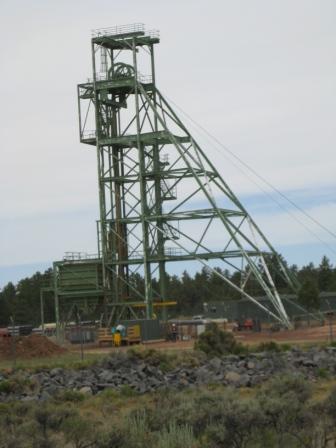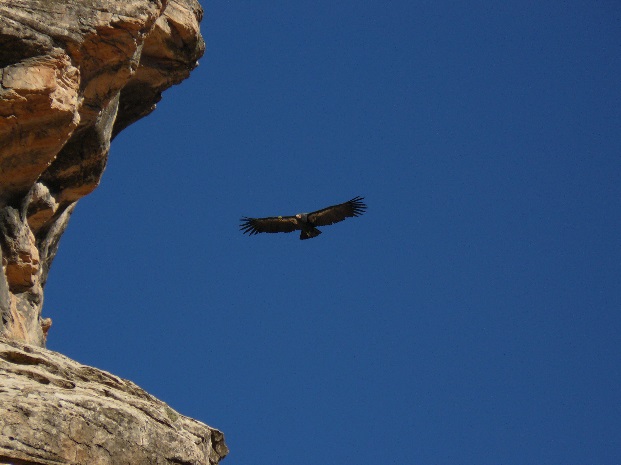An Open Letter to the Arizona Game and Fish Commission – Uranium Mines Do Threaten Wildlife
 The Arizona Game and Fish Commission seems more interested in playing politics than in considering legitimate concerns facing wildlife and habitat. Its statement about uranium mining being a “non-existent threat” to condors is just wrong. No one disagrees with the fact that lead poisoning is the number one threat and number one killer of condors – that’s why we advocate for a ban on lead ammunition. However, contrary to what the Commission claimed in its recent media release, federal wildlife and land management experts have also long had concerns about the impacts of uranium mining on condors and other wildlife. Such effects include both the mining process and the associated hazardous materials.
The Arizona Game and Fish Commission seems more interested in playing politics than in considering legitimate concerns facing wildlife and habitat. Its statement about uranium mining being a “non-existent threat” to condors is just wrong. No one disagrees with the fact that lead poisoning is the number one threat and number one killer of condors – that’s why we advocate for a ban on lead ammunition. However, contrary to what the Commission claimed in its recent media release, federal wildlife and land management experts have also long had concerns about the impacts of uranium mining on condors and other wildlife. Such effects include both the mining process and the associated hazardous materials.
In fact, concerns were raised as far back as 2002. U.S. Fish and Wildlife Service (USFWS) biologists, tasked with ensuring the success of the condor’s recovery from near extinction, concluded abandoned uranium mines were a threat. In its five-year review of the condor reintroduction program, USFWS noted the following: “At the Orphan Mine in Grand Canyon National Park, condors have been perching on the tower above the mine shaft…and from there investigating the associated ground debris and structures. The area surrounding this abandoned uranium mine is designated a hazardous waste site. Condors have been observed with their heads thoroughly coated in mine residue, potentially exposing them to various environmental contaminants” (https://www.fws.gov/cno/es/calcondor/pdf_files/1st-5yr-reviewreport.pdf, p. 23). Concerns about condor exposure to these contaminants was part of the impetus for the National Park Service to begin cleaning up Orphan Mine.
The Commission itself has expressed concerns about effects of uranium mining on wildlife and habitat and has supported a permanent ban on uranium mining near Grand Canyon. In a March 2008 letter to Senator McCain, it “express[es] concerns regarding the potential impacts to wildlife and wildlife habitats through proposed uranium development on lands in the proximity of Grand Canyon National Park.” The letter also notes that the Commission “opposes uranium development in the proximity of Grand Canyon National Park” and requests that Congress consider “permanent withdrawal” of the area from mining activities (Uranium Development near Grand Canyon National Park letter, March 17, 2008).
Game and Fish further recognized the potential negative impacts to wildlife from uranium mining in comments on the proposed mineral withdrawal. Game and Fish indicated that uranium mining activities “have the potential to affect wildlife directly by displacing wildlife due to mining activity, indirectly by fragmenting intact habitat, and adding toxic materials to the environment” (AZ Game and Fish email communication to BLM, March 5, 2010).
 The Forest Service and other agencies also raised concerns in 2008 and included additional protective measures for an exploratory uranium drilling project: “If a condor shows up at a drill site, the Forest Service will be contacted immediately and any project-related activity likely to harm the condor will halt temporarily until the condor flies away or is driven away by permitted personnel (FWS or Peregrine Fund personnel). Project workers will be instructed to avoid interaction with condors” (Amendment for VANE Minerals Decision Memo, February 6, 2008).
The Forest Service and other agencies also raised concerns in 2008 and included additional protective measures for an exploratory uranium drilling project: “If a condor shows up at a drill site, the Forest Service will be contacted immediately and any project-related activity likely to harm the condor will halt temporarily until the condor flies away or is driven away by permitted personnel (FWS or Peregrine Fund personnel). Project workers will be instructed to avoid interaction with condors” (Amendment for VANE Minerals Decision Memo, February 6, 2008).
The National Park Service also found that activities associated with uranium mining are a threat to wildlife. It stated, “Waste water associated with uranium mining operations contains high concentrations of a variety of metals and other chemicals associated with the mining process (Kaufman et al. 1976). These waste waters are usually stored in nearby evaporation ponds for remediation. The surface evaporation ponds will serve as an attractant and may represent a significant hazard to wildlife” (National Park Service Potential Impacts of Uranium Mining on Wildlife Resources, January 2010).
In consultation between the Bureau of Land Management and the USFWS related to the mineral withdrawal for one million acres of public lands around Grand Canyon, USFWS stated that the withdrawal would “remove potential threats” to imperiled wildlife. With respect to condors, specifically, the USFWS found that the withdrawal would “protect these species [condors and Mexican spotted owls] from mining-related effects associated with human disturbance, human interactions, and potential contamination of food or prey items” (Request for Concurrence for Northern Arizona Mineral Withdrawal, August 29, 2011).
Although the mineral withdrawal is in place for a portion of the lands included in the proposed Greater Grand Canyon Heritage National Monument, it is only a temporary withdrawal and is also being challenged by mining interests. National monument designation would eliminate future uranium mining, thus providing long-term protection for condors and other wildlife related to the exposure to uranium and other toxins associated with uranium mining, including exposure via the waste water. The monument would provide protection for landscape-scale habitat blocks and key wildlife corridors, as well, which is yet another reason the Game and Fish opposition to the proposed national monument is incongruent with its mission. The monument would not, as Game and Fish claims, affect hunting, fishing, or other outdoor recreation opportunities.
Perhaps the key question here is not whether uranium mines can hurt wildlife, including condors. It seems clear that they can. The key question is why is Arizona Game and Fish no longer concerned about the impacts of uranium mining on wildlife? Why does it not support protection of wildlife habitat? And why is it supporting mines instead of monuments? Game and Fish seems to have lost touch with its mission when it comes to northern Arizona’s public lands. It should get back to wildlife conservation and stop the political grandstanding.
Sincerely,
Sandy Bahr
Chapter Director
Sierra Club – Grand Canyon Chapter
For more information on uranium mining impacts, please see this 2007 report from the AZ Game and Fish Department here.